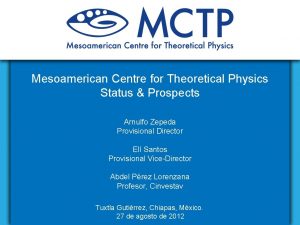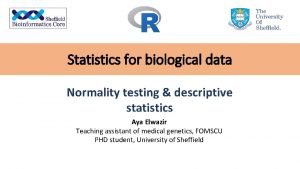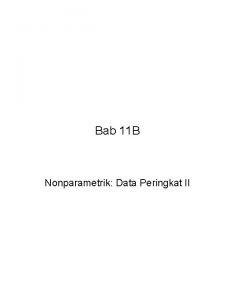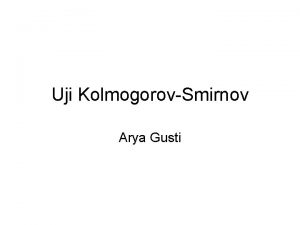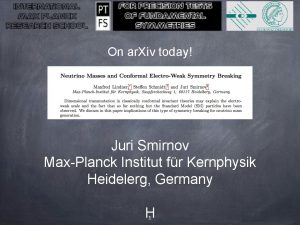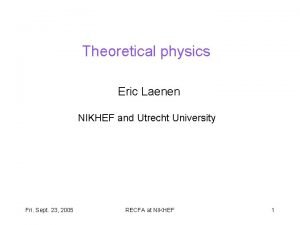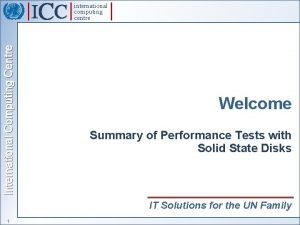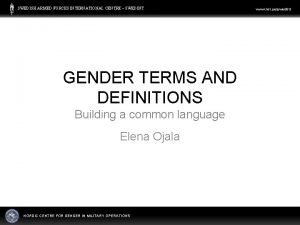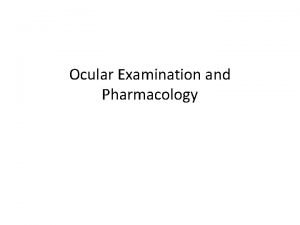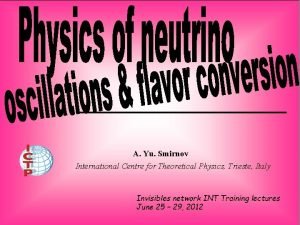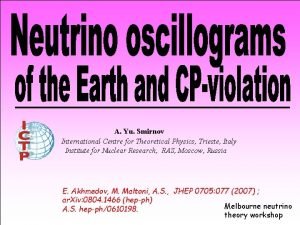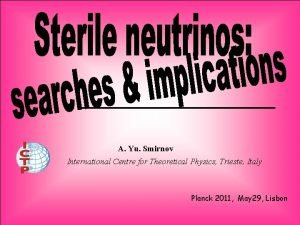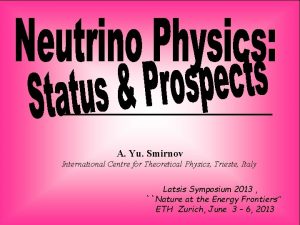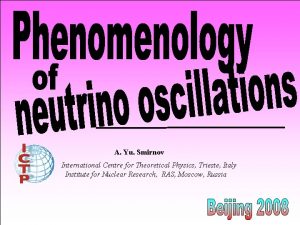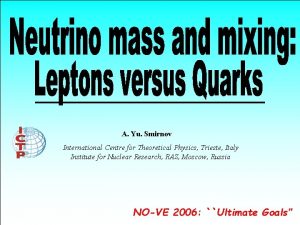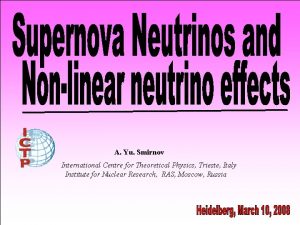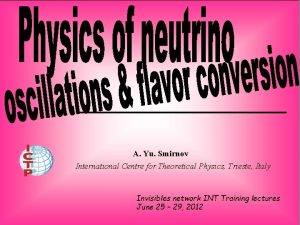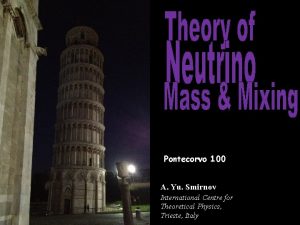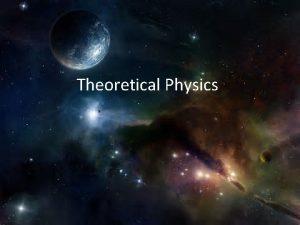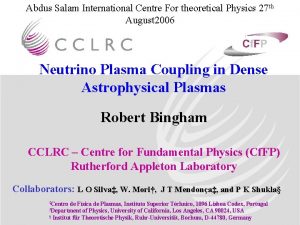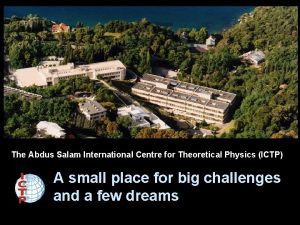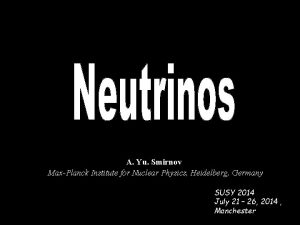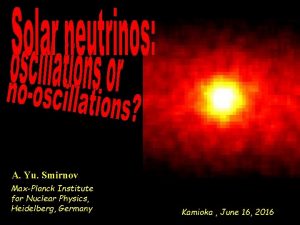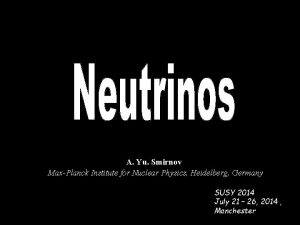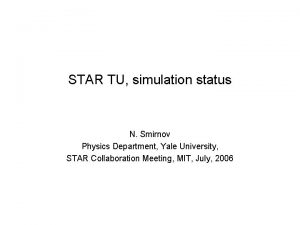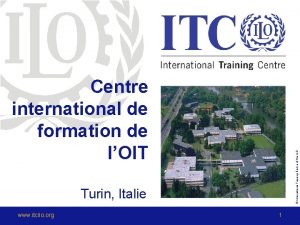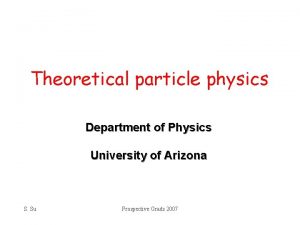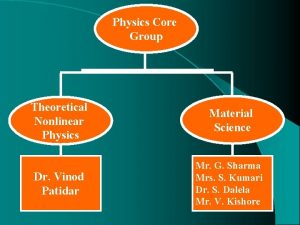A Yu Smirnov International Centre for Theoretical Physics







![[1] Neutrino production coherence and oscillation experiments. E. Akhmedov, D. Hernandez, A. Smirnov, JHEP [1] Neutrino production coherence and oscillation experiments. E. Akhmedov, D. Hernandez, A. Smirnov, JHEP](https://slidetodoc.com/presentation_image_h/05c2d84a0ae6f1b9398d4330ffd70b0c/image-8.jpg)






























































- Slides: 70

A. Yu. Smirnov International Centre for Theoretical Physics, Trieste, Italy Invisibles network INT Training lectures June 25 – 29, 2012

Modern version

Oscillation and flavor conversion are consequence of - the lepton mixing and - production of mixed (flavor) states also to set notations

ne nm nt |Um 3 n 3 mass |Ue 3 n 2 n 1 |2 Mixing parameters |Ut 3|2 tan 2 q 12 = |Ue 2|2 / |Ue 1|2 sin 2 q 13 = |Ue 3|2 |2 |Ue 2|2 Dm 231 Dm 221 |Ue 1|2 flavor Normal mass hierarchy Dm 231 = m 23 - m 21 Dm 221 = m 22 - m 21 tan 2 q 23 = |Um 3|2 / |Ut 3|2 Mass states can be enumerated by amount of electron flavor Mixing matrix: nf = UPMNS nmass n 1 ne nm = UPMNS n 2 n 3 nt UPMNS = U 23 Id U 13 I-d U 12

Mixing in CC mixing in produced states Non-trivial interplay of Charged current weak interactions Kinematics of specific reactions ne b- decays, energy conservation nm p- decays, chirality suppression nt Beam dump, D - decay What about neutral currents? Difference of the charged lepton masses Breaking of coherence

Z is flavor blind What is the neutrino state produced in the Z-decay in the presence of mixing? Z 0 ni f = f H Z ni 1 [ n n 1 1 3 2 = 3 + n 2 n 2 n 1 H Z + n 3 n 3 ] 2 Do neutrinos from Z 0 - decay oscillate? Two detectors experiment: detection of both neutrinos If the flavor of one of the neutrino is fixed, another neutrino oscillates L 1 L 2 P = sin 2 2 q sin 2 [ p (L 1 + L 2)/ ln]

a p t ithou W s e x o rad Challenging theory of neutrino oscillations Simple and straightforward New aspects and still correct New experimental setups - LBL long tunnels - Long leaved parents
![1 Neutrino production coherence and oscillation experiments E Akhmedov D Hernandez A Smirnov JHEP [1] Neutrino production coherence and oscillation experiments. E. Akhmedov, D. Hernandez, A. Smirnov, JHEP](https://slidetodoc.com/presentation_image_h/05c2d84a0ae6f1b9398d4330ffd70b0c/image-8.jpg)
[1] Neutrino production coherence and oscillation experiments. E. Akhmedov, D. Hernandez, A. Smirnov, JHEP 1204 (2012) 052, ar. Xiv: 1201. 4128 [hep-ph] [2] Neutrino oscillations: Entanglement, energy-momentum conservation and QFT. E. Kh. Akhmedov, A. Yu. Smirnov, Found. Phys. 41 (2011) 1279 -1306 ar. Xiv: 1008. 2077 [hep-ph] [3] Paradoxes of neutrino oscillations. E. Kh. Akhmedov, A. Yu. Smirnov Phys. Atom. Nucl. 72 (2009) 1363 -1381 ar. Xiv: 0905. 1903 [hep-ph] [4] Active to sterile neutrino oscillations: Coherence and MINOS results. D. Hernandez, A. Yu. Smirnov, Phys. Lett. B 706 (2012) 360 -366 ar. Xiv: 1105. 5946 [hep-ph] [5] Neutrino oscillations: Quantum mechanics vs. quantum field theory. E. Kh. Akhmedov, J. Kopp, JHEP 1004 (2010) 008 ar. Xiv: 1001. 4815 [hep-ph]

Pisa, 1913 B. Pontecorvo ``Mesonium and antimesonium’’ Zh. Eksp. Teor. Fiz. 33, 549 (1957) [Sov. Phys. JETP 6, 429 (1957)] translation mentioned a possibility of neutrino mixing and oscillations Oscillations imply non-zero masses (mass squared differences) and mixing Proposal of neutrino oscillations by B Pontecorvo was motivated by rumor that Davis sees effect in Cl-Ar detector from atomic reactor

Lagrangian g l g m (1 - g 5)nl W+m 22 Amplitudes, probabilities of processes - ½ m. L n. LTCn. L - l. L ml l. R + h. c. Starting from the first principles QFT QM Observables, Number of events, etc. .

Formalism should be adjusted to specific physics situation Initial conditions Approximations, if one does not want to consider whole history of the Universe to compute signal in Daya Bay Truncatin g the process Recall, the usual set-up asymptotic states described by plane waves - enormous simplification single interaction region

External particles S production region E. Akhmedov, A. S. ni baseline L Finite space and time phenomenon Two interaction regions in contrast to usual scattering problem Neutrinos: propagator QFT but D detection region formalism should be adjusted to these condition Finite space-time integration limits wave packets for external particles ut abo o f n i encode duction and pro ons finite i g e r n etectio

B. Kayser, Phys. Rev D 48 (1981) 110 Wave packet formalism. Consistent description of oscillations requires consideration of wave packets of neutrino mass states. 31 years later, GGI lectures: istication: ph so of l ve le t es gh hi The rrect result! co t ge d an s as m no ri neut to use proper time for Key point: phases of mass eigenstates should be compared in the same space-time point If not - factor of 2 in the oscil lations phase

How external particles Should be described? External particles S production region ni baseline L detection/production areas are determined by localization of particles involved in neutrino production and detection not source/detector volume (still to integrate over) D detection region wave packets for external particles Describe by plane waves but introduce finite integration

External particles S production region ni baseline L D detection region wave packets for external particles Unique process, neutrinos with definite masses are described by propagators, Oscillation pattern – result of interference of amplitudes due to exchange of different mass eigenstates Very quickly converge to mass shell Real particles – described by wave packets

S production region ni baseline L If oscillation effect in Production/detection regions can be neglected r. D , r. S << ln D detection region factorization Production propagation and Detection can be considered as three independent processes

Without flavor states ni Scattering g U l g m (1 - g ) n W+ + h. c. 5 i m 2 2 li l W N p m ni p ni m interaction constant Eigenstates of the Hamiltonian in vacuum Lagrangian of interactions wave functions of accompanying particles compute the wave function of neutrino mass eigenstates Wave packet

In general Suppose na be produced in the source centered at x = 0, t = 0 After formation of the wave packet (outside the production region) |na (x, t)> = Sk Uak* Yk(x, t)|nk> Yk ~ dp fk(p – pk) e Ek(p)= p 2 + mk 2 ipx – i. Ek(p)t - dispersion relation fk(p – pk) - the momentum distribution function peaked at pk - the mean momentum describes spread of the wave packets Expanding around mean momentun Ek(p) = Ek(pk) + (d. Ek/dp) (p - pk) + (d. Ek 2/dp 2) (p - pk)2 + … pk pk vk= (d. Ek/dp) = (p/Ek) pk pk - group velocity of nk

(neglecting spread of the wave packets) Ek(p) = Ek(pk) + vk(p - pk) Inserting into Yk ~ e Yk ~ dp fk(p – pk) e ipkx – i. Ek(pk)t Phase factor e ifk f k = p k x – Ek t Depends on mean characteristics pk and corresponding energy: Ek(pk) = pk 2 + mk 2 ipx – i. Ek(p)t gk(x – vkt) Shape factor ip(x – vkt) gk(x – vkt) = dp fk(p) e Depends on x and t only in combination (x – vkt) and therefore Describes propagation of the wave packet with group velocity vk without change of the shape

ne ne = cosq n 1 + sinq n 2 nm = - sinq n 1 + cosq n 2 cosq opposite phase sx n 1 = cosq ne - sinq nm n 2 = cosq nm + sinq ne n 1 e of nc e r e f r e Int sinq or p v a l f e am the s n 2 x f =0 arts Main, effective frequency |n (x, t)> = cosq g 1(x – v 1 t)e if 1 |n 1> + sinq g 2(x – v 2 t)e if 2 |n 2 > f = f 2 - f 1 Oscillation phase

One needs to compute the state which is produced i. e. compute the shape factors t) v – k x ( gk - Fundamental interactions - Kinematics - characteristics of parent and accompanying particles mean moment a pk Process dependent If heavy neutrinos are present but can not be produced for kinematical reasons, flavor states in Lagrangian differe from the produced states, etc. .

What happens? Due to different masses (dispersion relations) phase velocities Due to different group velocities Due to presence of waves with different momenta and energy in the packet

f = f 2 - f 1 fi = - E i t + p i x pi = E i 2 – m i 2 Dispersion relation enters here f = DEt - Dpx Dp = (dp/d. E) DE + (dp/dm 2) Dm 2 = 1/vg DE + (1/2 p) Dm 2 group velocity Dm 2 f = DE/vg (vgt - x) + x 2 E DE 0 ~ Dm 2/2 E < sx sx. Dm 2/2 E standard oscillation phase Effect of averaging over size of the wave packet usually- small

ne + nm ne = cosq n 1 + sinq n 2 nm = - sinq n 1 + cosq n 2 cosq opposite phase sx Interference pattern depends on relative (oscillation) phase n 1 sinq n 2 x f =p Main, effective frequency |n (x, t)> = cosq g 1(x – v 1 t)|n 1> + sinq g 2(x – v 2 t)e if |n 2 > f = f 2 - f 1 Oscillation phase

ne cosq sx - Destructive interference of the muon parts - Constructive interference of electron parts n 1 sinq n 2 x f =0

ne + nm cosq sx - Destructive interference of the electron parts - Constructive interference of muon parts n 1 sinq n 2 x f =p

As important as production Should be considered symmetrically with production Detection effect can be included in the generalized shape factors gk(x – vkt) Gk(L – vkt) x L - distance between central points of the production and detection regions HOMEWORK…

Amplitude of (survival) probability A(ne) = <ne|n (x, t)> = cos 2 q g 1(x – v 1 t) + sin 2 q g 2(x – v 2 t) e if inteference Probability P(ne) = dx |<ne|n (x, t)>|2 = (integra tion ove r the de tection = cos 4 q + sin 4 q + 2 sin 2 q cos f dx g 1(x – v 1 t) g 2(x – v 2 t) If g 1 = g 2 P(ne) = 1 - 2 sin 2 q cos 2 q (1 - cos f) = 1 - sin 2 2 q sin 2 ½f 2 px Dm 2 x f= = ln 2 E ln = 4 p 2 E Dm Oscillation length depth of oscillations area)

P(nm) = sin 22 q sin 2 px ln All complications – absorbed in normalization or reduced to partial averaging of oscillations or lead to negligible corrections of order m/E << 1 ifference d e s a h p e h t f o t ec Oscillations - eff nstates e ig e s s a m n e e w increase bet Admixtures of the mass eigenstates ni in a given neutrino state do not change during propagation Flavors (flavor com position) of the eig enstates are fixed by the v acuum mixing angle

In the configuration space: separation of the wave packets due to difference of group velocities Dvgr = Dm 2 /2 E 2 separation: Dvgr L = Dm 2 L/2 E 2 sx n 1 no overlap: Dvgr L > sx n 2 x In the energy space: period of oscillations Averaging (loss of coherence) if energy resolution s. E is bad: coherence length: Lcoh = sx E 2/Dm 2 DE = 4 p. E 2/(Dm 2 L) DE < s. E Coherence is determined by conditions of detection If DE > s. E - restoration of coherence even if the wave packets separated

E. Akhmedov, D. Hernandez, A. S. Pion decay: gi(x, t) e ifi = dx. S dt. S M yp (x. S, t. S) ym (x. S, t. S) exp[ ip i( x - x. S) – i. Ei (t – t. S)] integration over production region part of matrix element plane wave for neuutrino Pion wave function: y p (x. S, t. S) = exp[ –½Gt. S] gp(x. S, t. S) exp[ -ifp(x. S, t. S)] usually: gp(x. S, t. S) ~ d (x. S - vpt. S) Muon wave function: y m (x. S, t. S) = gm(x’ - x. S, t’ - t. S) exp[ ifm (x’ - x. S , t’ - t. S)] determined by detection of muon

p target p n lp decay tunnel L absorber detector D. Hernandez, AS E. Kh Akhmedov, D. Hernandez, AS ar. Xiv: 1110. 5453 n wave packet x The length of the n wave packet emitted in the forward direction Shape factor g = g 0 exp s = lp v – vp vp G (x - s) P(x, [0, s]) 2(v - vp) box function Doppler effect

L p n D. Hernandez, AS lp sin 22 q 1 P=P+ [cos f. L + K] 2(1 + x 2) 1 – e-Glp x = Dm 2/2 EG decoherence parameter K = x sin f. L - e-Glp[cos(f. L - fp) - xsin (f. L - fp)] f. L = Dm 2 L/2 E fp = Dm 2 lp/2 E MINOS: x ~ 1 b-beam ? Incoherent n-emission - short WP Coherent n-emission - long WP Equivalence x x

x XD detector n lp m p XT target pion Coherent emission of neutrino by pion along its trajectory t

x XD detector n lp p integration XT target pion m If pion ``pointlike – result coincides with usual incoherent computations; otherwise – integration – corrections ~ sp t

Q x XD detector n 2 lp p XT target p n 1 m pion t

If loss of coherence and other complications related to WP picture are irrelevant – point-like picture d. Y i = HY dt ye Y = ym yt M M+ H= + V(t) 2 E M is the mass matrix V = diag (Ve , 0, 0) – effective potential Mixing matrix in vacuum M M+ = U Mdiag 2 U+ Mdiag 2 = diag (m 12, m 22, m 32)

y= Polarization vector: ne nt , P = y+ s/2 y P= Re ne+ nt, Im ne+ nt, ne+ ne - 1/2 Evolution equation: d. Y i = HY dt d. Y i d t = (B s ) Y B= 2 p (sin 2 qm, 0, cos 2 qm) lm Differentiating P and using equation of motion d. P = ( B x P) dt Coincides with equation for the electron spin precession in the magnetic field

n =P = (Re ne+ nt, Im ne+ nt, ne+ ne - 1/2) B= ne 2 p (sin 2 qm, 0, cos 2 qm) lm nt, Evolution equation dn = ( B x n) dt f = 2 pt/ lm - phase of oscillations P = ne+ne = n. Z + 1/2 = cos 2 q. Z/2 probability to find ne









L - baseline source Near detector Far detector na disappearance na nb Oscillation probability – periodic function of - Distance L and - Inverse energy 1/E appearance

nm ne ne nm nm

nm nt Distortion of the nm - wave packet due to oscillations leads to shift of the center of mass of the packet The oscillation phase which describes distortion Key point fp = 2 p s ln (v – vp) = 2 p lp / l n equals the phase acquired over the region of formation of the wave packets

D. Henandez, A. S. P(nm nm) MINOS, ND Coherence: DE ~ G ldecay ~ ln with decoherence

Analogy with quark sector? mass state In practice: ni Scattering l s ~ |Uil|2 W N p m ni p ni G ~ |U im |2 No beams of neutrino mass eigenstates No neutrino mass spectrometer m The problem: neutrinos are in the coherent (flavor) states Standard methods do not work lead to new effects which allow to measure mixing parameters

Theory of oscillations: Quantum mechanics at macroscopic distances ntum e m o m Energy ation Kinematic conserv entanglment Coherenc e of prod uction agation Coherence in prop Search for n ew realizatio ns of the oscilla tion setup Phenomenolo gical consequ ences ive t c e l l o C s effect lations Interplay of oscil andard with other non-st effects Academic interest? ith w g n i t la Manipu etup s n o i t a oscill Identify origins of neutrino mass

Space-time localization energy-momentum uncertainty, DE , D p Generic feature of oscillation set-up Nuclei decay n e system h t le o h w in d e m is conserv u t n e ns localize m io o t m c a y r g e r t in Ene e s o particles wh o ls a s e d lu c in which s, etc). ll a (w s t n e r a p neutrino E-p are not conserved in the sub-system: particles which Directly involved in the process of neutrino production of the wave packets. s nt ne po m co al du vi di in r E-p can be conserved fo ility is convoluted ab ob pr e th n he w ed or st Uncertainty is re with wave packets

Exact energy-momentum conservation: kinematic entanglement p nm + m p ni + m Final state: |f Evolved: |f i = 1, 2 mi is the state which (kinematically) corresponds mass eigenstate ni = Si|mi |ni = S|mi |ni eifi(n) e ifi(m) Does recoil (muon) phase contribute to the oscillation phase? For muon: p 2 = E 2 – m 2 Dp = E/p DE = 1/vg DE 2 p Dp = 2 EDE f = DEt – Dpx = DE(t – x/vg) ~ DE sx x = vgt no mass difference between two muon components vg= p/E Related to uncertainty of the phase due to localization

m production region n fixed s i e t a t s utrino e n f o r o v a Fl uction d o r p e h t at This does n ot depend o n where and muon is det how ected and o n what is th difference e phase between th e muon com ponents Neutrino phase difference is determined by neutrino parameters

Z is flavor blind What is the neutrino state produced in the Z-decay in the presence of mixing? Z 0 ni f = f H Z ni 1 [ n n 1 1 3 s 2 = 3 + n 2 n 2 n 1 H Z + n 3 n 3 ] 2 Do neutrinos from Z 0 - decay oscillate? Two detectors experiment: detection of both neutrinos If the flavor of one of the neutrino is fixed, another neutrino oscillates L 1 L 2 P = sin 2 2 q sin 2 [ p (L 1 + L 2)/ ln]

Flavors of mass eigenstates do not change Admixtures of mass eigenstates do not change: no n 1 <-> n 2 transitions ne Determined by q n 2 n 1 Df = 0 Df = Dvphase t Due to difference of masses n 1 and n 2 have different phase velocities effects of the phase difference increase which changes the interference pattern

P(nm) = 2 px Ap 1 - cos 2 ln = sin 22 q sin 2 px ln Features of neutrino oscillations in vacuum: Oscillations -- effect of the phase difference increase between mass eigenstates Admixtures of the mass eigenstates ni in a given neutrino state do not change during propagation Flavors (flavor composition) of the eigenstates are fixed by the vacuum mixing angle A Yu Smirnov

All well established/confirmed results are described by Sun Atmosphere The Earth Geo-nu SN 1987 A Universe ly) (indirect Accelerators Reactors Rad. Sou rces + with s o n i r t u ne of three uliar pattern ec rather p Introduction of neutrino mass and mixing may have negligible impact on the rest of SM 1 mass is generated by LLHH L other effects ~ L-2

Chiral components ne e L nm m L nt t L IW = 1/2 I 3 W = 1/2 n L = ½(1 - g 5) n n R = ½(1 + g 5) n ? are neutrino flavor states form doublets (charged currents) with definite charged leptons, ne nm nt nl l l = e, m, t W g l gm (1 - g 5) nl W+m + h. c. 22 Conservation of lepton numbers Le, Lm, Lt nl nl Z g nl gm (1 - g 5)nl Zm 4 Neutral current interaction

ect ff MSW-e Oscillati ons Can be resonantly enhanced in matter

Origin of mixing: off diagonal mass matrices Ml = M n Diagonalization: Ml = Ul. Lmldiag Ul. R+ Mixing matrix Mass spectrum Mn = Un. Lmndiag Un. LT (Majorana neutrinos) mndiag = (m 1, m 2, m 3) CC in terms of mass eigenstates: l g m (1 - g 5) UPMNSnmass U PMNS = Ul. L+ Un. L Flavor basis: Ml = mldiag U PMNS = Un. L

UPMNS = U 23 Id U 13 I-d U 12 c 12 c 13 UPMNS = Id = diag (1, 1, eid) s 12 c 13 s 13 e-id s 12 c 23 + c 12 s 23 s 13 eid c 12 c 23 - s 12 s 23 s 13 eid - s 23 c 13 s 12 s 23 - c 12 c 23 s 13 eid c 12 s 23 + s 12 c 23 s 13 eid c 23 c 13 c 12 = cos q 12 , etc. d is the Dirac CP violating phase q 12 is the ``solar’’ mixing angle q 23 is the ``atmospheric’’ mixing angle q 13 is the mixing angle determined by T 2 K, Daya Bay, DC, RENO …

Why the standard oscillation formula is so robust? Corrections required ? New oscillation setups Higher precision … LBL experiments: - Long life-time parents: pions, muons, nuclei; - large decay pipes, straight lines of storage rings Neutrino anomalies as consequences of modified description of oscillations Nature of neutrino mass differs from nature of electron or top quark…

Chiral components ne e L nm m L nt t L IW = 1/2 I 3 W = 1/2 n L = ½(1 - g 5) n n R = ½(1 + g 5) n ? are neutrino flavor states form doublets (charged currents) with definite charged leptons, ne nm nt nl l l = e, m, t W g l g m (1 - g 5)nl W+m + h. c. 22 Conservation of lepton numbers Le, Lm, Lt nl nl Z Neutral current interaction g nl g m (1 - g 5)nl Zm 4

How external particles Should be described? External particles S production region ni baseline L detection/production areas are determined by localization of particles involved in neutrino production and detection not source/detector volume (still to integrate over) D detection region wave packets for external particles Describe by plane waves But introduce finite integration

on mass shell ni production region detection region Neutrinos real particles described by the wave packets Which encode information about production and detection as well on oscillations in the production region

Flavor neutrino states: ne e nm m Mass eigenstates nt n 1 n 2 n 3 m 1 m 2 m 3 t - correspond to certain charged leptons - interact in pairs flavor is characteristic of interactions n p + e - + ne p m + nm Flavor states = Mass eigenstates

 Mesoamerican centre for theoretical physics
Mesoamerican centre for theoretical physics Apa itu uji normalitas
Apa itu uji normalitas Kolmogorov-smirnov test for normality
Kolmogorov-smirnov test for normality Plot adalah
Plot adalah Tabel kolmogorov smirnov
Tabel kolmogorov smirnov Kelebihan uji kolmogorov smirnov
Kelebihan uji kolmogorov smirnov Juri smirnov
Juri smirnov Alma integration profile
Alma integration profile Nikhef theory
Nikhef theory Theoretical foundation of international business
Theoretical foundation of international business Centroid in engineering mechanics
Centroid in engineering mechanics Difference between centre of gravity and centroid
Difference between centre of gravity and centroid International training centre of the ilo
International training centre of the ilo Itc ilo turin
Itc ilo turin Ditc australia
Ditc australia Swedish armed forces international centre
Swedish armed forces international centre International geneva welcome centre
International geneva welcome centre International computing centre
International computing centre Nordic centre for gender in military operations
Nordic centre for gender in military operations International pharmacovigilance centre
International pharmacovigilance centre Who collaborating centre for international drug monitoring
Who collaborating centre for international drug monitoring International centre for eye health
International centre for eye health Why does it happen
Why does it happen University physics with modern physics fifteenth edition
University physics with modern physics fifteenth edition Ia physics ideas
Ia physics ideas Iso 22301 utbildning
Iso 22301 utbildning Typiska novell drag
Typiska novell drag Tack för att ni lyssnade bild
Tack för att ni lyssnade bild Returpilarna
Returpilarna Varför kallas perioden 1918-1939 för mellankrigstiden?
Varför kallas perioden 1918-1939 för mellankrigstiden? En lathund för arbete med kontinuitetshantering
En lathund för arbete med kontinuitetshantering Kassaregister ideell förening
Kassaregister ideell förening Tidbok
Tidbok A gastrica
A gastrica Densitet vatten
Densitet vatten Datorkunskap för nybörjare
Datorkunskap för nybörjare Boverket ka
Boverket ka Att skriva en debattartikel
Att skriva en debattartikel Delegerande ledarskap
Delegerande ledarskap Nyckelkompetenser för livslångt lärande
Nyckelkompetenser för livslångt lärande Påbyggnader för flakfordon
Påbyggnader för flakfordon Vätsketryck formel
Vätsketryck formel Publik sektor
Publik sektor Lyckans minut erik lindorm analys
Lyckans minut erik lindorm analys Presentera för publik crossboss
Presentera för publik crossboss Argument för teckenspråk som minoritetsspråk
Argument för teckenspråk som minoritetsspråk Bat mitza
Bat mitza Klassificeringsstruktur för kommunala verksamheter
Klassificeringsstruktur för kommunala verksamheter Luftstrupen för medicinare
Luftstrupen för medicinare Bästa kameran för astrofoto
Bästa kameran för astrofoto Centrum för kunskap och säkerhet
Centrum för kunskap och säkerhet Programskede byggprocessen
Programskede byggprocessen Bra mat för unga idrottare
Bra mat för unga idrottare Verktyg för automatisering av utbetalningar
Verktyg för automatisering av utbetalningar Rutin för avvikelsehantering
Rutin för avvikelsehantering Smärtskolan kunskap för livet
Smärtskolan kunskap för livet Ministerstyre för och nackdelar
Ministerstyre för och nackdelar Tack för att ni har lyssnat
Tack för att ni har lyssnat Referat mall
Referat mall Redogör för vad psykologi är
Redogör för vad psykologi är Stål för stötfångarsystem
Stål för stötfångarsystem Tack för att ni har lyssnat
Tack för att ni har lyssnat Borra hål för knoppar
Borra hål för knoppar Orubbliga rättigheter
Orubbliga rättigheter Standardavvikelse formel
Standardavvikelse formel Tack för att ni har lyssnat
Tack för att ni har lyssnat Rita perspektiv
Rita perspektiv Informationskartläggning
Informationskartläggning Tobinskatten för och nackdelar
Tobinskatten för och nackdelar Blomman för dagen drog
Blomman för dagen drog Datumr
Datumr
